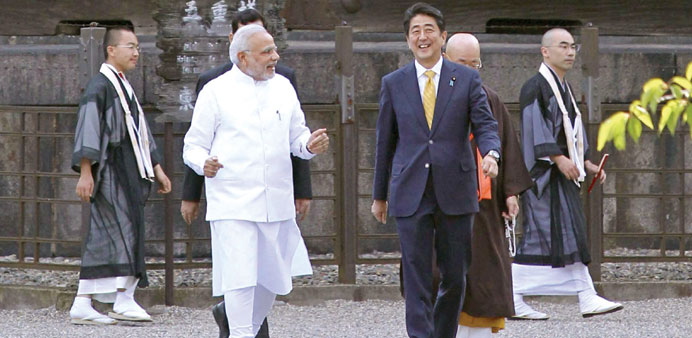Prime Minister Narendra Modi and his Japanese counterpart Shinzo Abe share a joke as they visit the Toji Buddhist temple, a Unesco World Heritage site, in Kyoto yesterday.
Agencies/Tokyo
Prime Minister Narendra Modi arrived in Tokyo after touring the ancient Japanese city of Kyoto yesterday, the second day of a visit intended to strengthen security and economic relations and counter an increasingly assertive China.
Modi was accompanied by Prime Minister Shinzo Abe on his visit to a historic temple in Kyoto a day after he had a private dinner with Abe.
It is unusual for a Japanese prime minister to greet a foreign guest outside Tokyo.
The two leaders visited the 1,200-year-old Buddhist temple of Toji, a World Heritage site, and offered prayers in front of ancient statues early yesterday.
They also took a short walk near a five-storey pagoda in the company of a priest. Buddhism, born in the Indian subcontinent, was brought to Japan through China and Korea in the sixth century.
Later in the day Modi met Nobel Prize-winning stem cell researcher Shinya Yamanaka, who heads the Center for iPS Cell Research and Application at Kyoto University and briefed the Indian leader about cutting-edge research.
They discussed the “possibilities of sickle cell anaemia cure” and “prospects of co-operation among Indian and Japanese institutes,” officials said.
“The prime minister expressed concern over the prevalence of sickle cell anaemia, especially among the tribal communities across India,” an official said.
Yamanaka said there were currently no Indian researchers at his institute, adding he would “like Indian scientists to conduct research at the institute.”
Modi arrived on Saturday at Kansai International Airport near the western city of Osaka by special plane for a night in nearby Kyoto.
He will hold an official summit with Abe in Tokyo today as well as meetings with business leaders.
Modi is one of only three people that Abe follows on Twitter, while the Indian leader admires the Japanese premier’s brand of nationalist politics.
“We will explore how Japan can associate itself productively with my vision of inclusive development in India,” Modi said before departing on Saturday for the visit.
He listed manufacturing, infrastructure and energy as key areas for co-operation. In his previous role as chief minister of Gujarat Modi had actively courted Japanese investment.
Modi, 63, is embarking on an intense month of diplomacy in which he will receive Chinese President Xi Jinping before meeting US President Barack Obama in Washington as he seeks to carve out a stronger role for India as a global player.
In Japan, he will lobby for Abe to back a nuclear energy pact, although hopes of striking a similar accord to one reached with the US in 2008 had faded in the run-up to the visit.
Japan wants explicit guarantees from India, which has not signed the nuclear non-proliferation treaty, to limit atomic tests and allow closer inspection of its facilities to ensure that spent fuel is not used to make bombs.
Modi will also seek to drum up the inward investment he needs to bring to life the appeal to “Come, make in India” he made in a speech this month to mark India’s Independence Day.
India needs faster economic growth to create work for the 1mn young people who enter the workforce every month.
In early steps, Modi has allowed foreign investors to own 100% of railway projects with an eye to drumming up interest in building India’s answer to Japan’s high-speed ‘bullet’ trains. He is also courting Japanese investment in an ambitious industrial “corridor” to run between Delhi and Mumbai.



